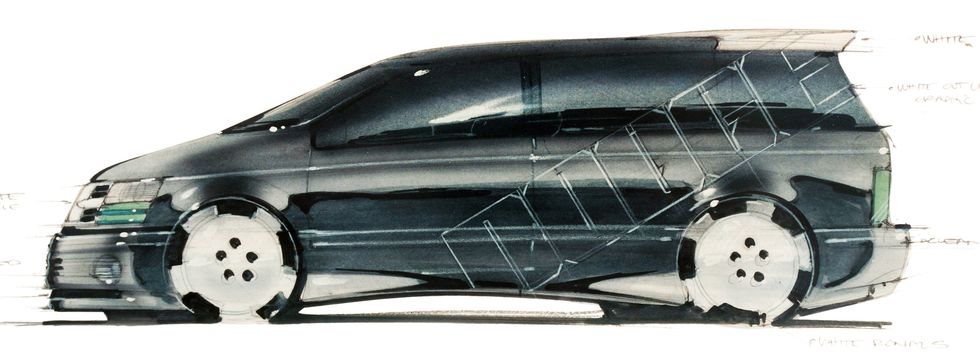In the late 1980s, fresh out of the industrial-design program at Pratt Institute, Michael Santoro took a job at Chrysler. He was one of a cohort of young designers, and since they had access to the corporate fleet, sometimes they’d borrow a car and drive from Detroit to New York City. One weekend, a colleague cadged a Chrysler minivan.
“We all looked at each other like, that’s the last car we’d want,” Santoro says. But they piled in and headed out. Not only did they arrive in record time, they enjoyed the drive too. “It was super comfortable. You could sleep. You had your own space. It was the coolest thing from a packaging standpoint, from a livability standpoint, from a functionality standpoint,” Santoro says. It just lacked a compelling design.
So when Santoro was approached in 1989 to conceptualize appeal-enhancing extensions for the minivan line, he was enthused. He sketched a slammed hot rod with monoblock wheels and blacked-out trim, a roofless beach cruiser with a washable interior, and a taxi with canary livery and huge graphics.
Then he tried a lifted model with a brush guard, wheel-arch flares, sidesteps, a roofmounted spare and light bar, and all-wheel drive (a coming van feature). “The more I sketched, the more excited upper management got,” Santoro says.
Investment in the project increased—a full-size concept was built and began to make the rounds internally. Eventually, Chrysler showed it to dealers. “And everybody loved it. Except the Jeep dealers. They were like, ‘No way. We don’t need a minivan Wrangler,’ ” Santoro says. He hypothesized that Jeep feared the cannibalization of sales or dilution of brand equity.
Jeep’s objections may have been significant, but the problems ran deeper. “l was certainly a proponent of trying to transition the commercially insignificant all-wheel-drive minivan into something more rugged and desirable,” says veteran auto exec Bob Lutz, then president of Chrysler. Unfortunately, given the company’s precarious finances, Santoro’s design was intended to be a purely cosmetic package, without any added capability. “All we were going to get was paint and tape. Maybe a wheel,” Santoro says.
That doomed the project for Lutz, who suspected such a trim version wouldn’t transform the van’s image. “Jeep dealers or not, this never would have gotten my approval,” Lutz says.
“lt’s not that Santoro wasn’t an excellent and highly valued designer,” he adds. “I’m sure he was simply responding as best he could to the often-ridiculous requests from the brand managers. That stroke of Iacocca reorganizational genius resulted in such memorable vehicles as the Dodge Dakota convertible pickup. That was the ultimate answer to a question nobody had asked.”
Contributing Editor
Brett Berk (he/him) is a former preschool teacher and early childhood center director who spent a decade as a youth and family researcher and now covers the topics of kids and the auto industry for publications including CNN, the New York Times, Popular Mechanics and more. He has published a parenting book, The Gay Uncle’s Guide to Parenting, and since 2008 has driven and reviewed thousands of cars for Car and Driver and Road & Track, where he is contributing editor. He has also written for Architectural Digest, Billboard, ELLE Decor, Esquire, GQ, Travel + Leisure and Vanity Fair.


